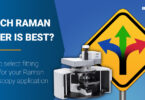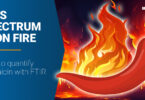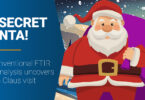Today we will look at what exactly a spectral library is, why we use it, what its strengths are, and why dedicated spectral libraries are so effective. So let’s start with the first question:
What is a spectral library?
Sometimes also called spectral reference library, it is the heart of any identification of an unknown substance by infrared or Raman spectroscopy. In fact, spectroscopic chemical analysis has widely replaced classical wet-chemical elucidation methods, removing the need for solvents and other consumeables. (much to the delight of the laboratory staff)
Usually, a select number of reference IR or Raman spectra of known substances is placed in such a library. In most cases, additional information like chemical structure or CAS will also be added.
Therefore, when an unknown substance is encountered the sample spectrum is compared to all the entries in this library, looking for the optimal fit.
Below you find a search result in the Bruker’s ATR Complete Library containing >26.000 spectra of common organics and inorganics. Usually, a fitting search result is highlighted as a winner together with close or related compounds. This way, the operator can double-check the result immediately.

What makes spectral libraries so effective?
Spectral reference libraries have become an indispensable part of everyday life in vibrational spectroscopy. However, it was not always easy to identify unknown spectra.
In the early days of spectroscopic investigation, printed spectra were held one on top of each other in backlight to look for similar spectral features. This means, that every lab had dozens of binders with printed spectra lying around. To add insult to injury, even experts had a hard time interpreting this data sometimes. And mixture analysis? A true nightmare?
But back to the present. Gone are the days when you had to compare IR spectra manually. Today, a spectrometers software uses smart algorithms to automatically look for the best match in your spectral library. With this, it is easier than ever to identify components in mixtures and to characterize complex substance blends with confidence.
This is exactly what makes it so effective. Its simplicity and efficiency. Especially by creating your own or commercial specialized libraries, analytical questions can be answered by everyone with high precision and reliability.
Why invest in dedicated spectral libraries?
Having a single, large spectral reference library that can analyze almost anything sounds tempting – but it also has drawbacks. Simply put, there are two major disadvantages that come to mind.
The more substances I have in my library, the more likely it is that two substances are similar in their spectral pattern. As a consequence, the identification result becomes less meaningful. And if you only work with polymers, why should you keep gas or pharmaceutical spectra in your library?
Furthermore, a simple equation applies: the more spectra in my library, the longer it takes to find the right result. So, a dedicated, lean library can lead me on the right track much faster than a comprehensive but sluggish one. And this is exactly where specialized, agile and efficient spectral libraries come in – but I’ll give you two examples.
Example #1: the KIMW polymer library
Imagine you are working as a polymer processor. You are constantly confronted with new materials, blends, fillers and much more. Keeping up with this (analytically) is an almost Sisyphean task.
Bruker partnered up with the renowned Polymer Institute of Luedenscheid (KIMW) to provide a comprehensive and focused set of polymer references for IR and Raman spectroscopy. As the KIMW acts as a consulting body for the plastics industry, all samples are carefully selected and archived after measurement.
With every reference spectrum, there comes a ton of additional information that you won’t find in any other polymer library like melting point, density, hardness and many more.
Example #2: the TICTAC drug library
Suppose your analysis decides whether someone faces serious consequences for possession of illegal drugs. Accordingly, you demand an unambiguous and reliable result with as little chance as possible for a false positive. Bruker has been working with TICTAC Communications LTD for years to provide exactly that.
The TICTAC Library is usually used in tandem with the ATR Complete Library. While the ATR complete sifts through the samples looking for true hazards, it identifies all diluents and lacing agents. Afterwards the TICTAC Library yields a conclusive result of the illicit substances involved.
It is a great example of where a lean, highly specialized library elevates a large, generalized libary for a truly comprehensive chemical analysis.
The real benefit: professional insights
A commercial, dedicated spectral library has another clear advantage that you can read between the lines. It is assembled, curated, and maintained by application experts.
Bruker is a company that knows everything about IR and Raman – but being a polymer or drug specialist is a label we do not apply to ourselves lightly. We trust in the power of knowledge and are not shy to ask the real experts when it comes to provide the best possible solution to our customers.
If you want to know more about our exclusive spectral libraries, contact us! We are looking forward to hearing from you. If not, check out the other stories on our blog.








